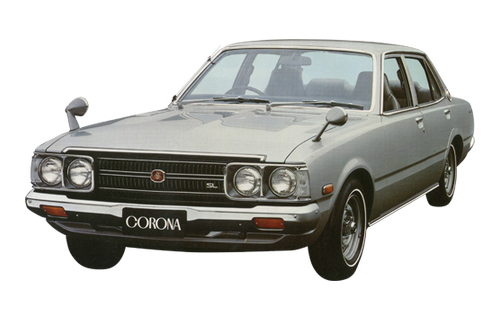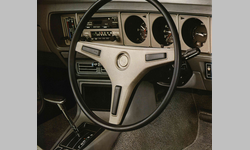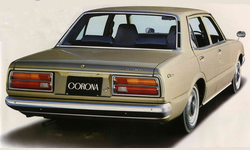

| Grade | Corona 1800GL | Corona 1800SL | Corona 2000GT | |
|---|---|---|---|---|
| Model type & weight |
Model type | RT102-YNF | RT102-MSFB | RT104-MQFG |
| Curb mass(kg) | 1025 | 1035 | 1090 | |
| Dimensions | Length(mm) | 4210 | 4210 | 4250 |
| Width(mm) | 1610 | 1610 | 1610 | |
| Height(mm) | 1390 | 1390 | 1390 | |
| Wheelbase(mm) | 2500 | 2500 | 2500 | |
| Engine | Engine code | 16R-B | 16R-B | 18R-G |
| Engine type | In-line 4-cylinder, OHC | In-line 4-cylinder, OHC | In-line 4-cylinder, DOHC | |
| Displacement(cm3) | 1808 | 1808 | 1968 | |
| Max. output kW(PS)/r.p.m. | -/105/5600 | -/110/6000 | -/145/6400 |
| * | The specifications are those of representative model grades. |
| * | Max. output represents a net rating. In the above table, digits separated by slashes ( / / ) stand for kW, PS, and r.p.m., respectively. |
| * | The model numbers of these vehicles are TT100(1600), RT102(1800), RT104(2000). |
| Plant | Tsutsumi plant, Kanto Auto Works,Ltd. |
|---|
"Toyopet" : The Toyopet brand name was chosen in a public naming competition. The "corona" is the ring of pearly light around the sun. The name was apt for this robust and approachable family car.






















One of the prominent design features of the fifth-generation Corona was its philosophy of preventive safety. For instance, the body was designed to absorb the impact of a front- or rear-end collision and mitigate the damage to the cabin. Selected models also featured the so-called OK monitor, a panel with 11 indicators designed to warn the driver of any safety-related irregularities. A large shock-absorbing bumper was also made available as an option, which was resilient and did not damage the body when the impact speed was 8 km/h or less.
The engine lineup consisted of a 1,600 cc 2T engine that was also fitted to the Carina and the Celica, 1,800 cc SOHC engines (16R/16R-B), a 2,000 cc SOHC EFI engine (18R-E), and a 2,000 cc DOHC unit (18R-G) that was exclusive to the 2000GT model. As the emission control was becoming increasingly stringent at the time, the Corona responded by progressively meeting the 1975 and 1976 emission standards from 1975 to 1976. By the end of 1977, all models except the 2,000 cc version had satisfied the 1978 emission standards.
Standard models used a conventional rigid axle leaf spring system for the rear suspension, although sports models adopted an equivalent of a 4-link rear suspension using anti-roll bars.